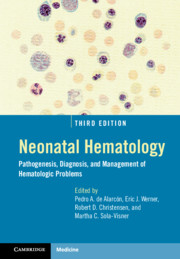Book contents
- Neonatal Hematology
- Neonatal Hematology
- Copyright page
- Contents
- Foreword
- Preface
- Contributors
- Section I Developmental Hematology
- Section II Bone Marrow Failure and Immune Disorders
- Section III Erythrocyte Disorders
- Chapter 6 Newborn Genetic Screening for Blood Disorders
- Chapter 7 A Guide to Identifying the Cause of Anemia in a Neonate
- Chapter 8 Anemia of Prematurity and Indications for Erythropoietin Therapy
- Chapter 9 Hemolytic Disease of the Fetus and Newborn
- Chapter 10 Neonatal Hemolysis
- Chapter 11 Polycythemia and Hyperviscosity in the Newborn
- Section IV Platelet Disorders
- Section V Leucocyte Disorders
- Section VI Hemostatic Disorders
- Section VII Neonatal Transfusion Medicine
- Section VIII Neonatal Oncology
- Section IX Miscellaneous
- Index
- Plate Section (PDF Only)
- References
Chapter 8 - Anemia of Prematurity and Indications for Erythropoietin Therapy
from Section III - Erythrocyte Disorders
Published online by Cambridge University Press: 30 January 2021
- Neonatal Hematology
- Neonatal Hematology
- Copyright page
- Contents
- Foreword
- Preface
- Contributors
- Section I Developmental Hematology
- Section II Bone Marrow Failure and Immune Disorders
- Section III Erythrocyte Disorders
- Chapter 6 Newborn Genetic Screening for Blood Disorders
- Chapter 7 A Guide to Identifying the Cause of Anemia in a Neonate
- Chapter 8 Anemia of Prematurity and Indications for Erythropoietin Therapy
- Chapter 9 Hemolytic Disease of the Fetus and Newborn
- Chapter 10 Neonatal Hemolysis
- Chapter 11 Polycythemia and Hyperviscosity in the Newborn
- Section IV Platelet Disorders
- Section V Leucocyte Disorders
- Section VI Hemostatic Disorders
- Section VII Neonatal Transfusion Medicine
- Section VIII Neonatal Oncology
- Section IX Miscellaneous
- Index
- Plate Section (PDF Only)
- References
Summary
Anemia of prematurity is a multifactorial anemia, characterized by relatively low plasma erythropoietin (EPO) levels, iatrogenic blood loss, low circulating blood volumes and insufficient erythropoiesis. This anemia has been long characterized as nutritionally insensitive, but nutrition may influence its clinical course. Anemia of prematurity is treated with erythrocyte transfusions. However, delaying umbilical cord clamping may increase initial hematocrit percentages, improve infant iron status, prevent erythrocyte transfusions, decrease necrotizing enterocolitis (NEC), and decrease intraventricular hemorrhage (IVH). Many published studies have examined the potential of therapy with recombinant human EPO or other erythropoietic stimulating agent (ESA). Although EPO therapy is associated with statistically lower number of total erythrocyte transfusions, most early transfusions are not eliminated. However, early erythropoietic EPO dosing may also decrease NEC and IVH as well as improve neurocognitive outcomes. A recent systematic review refuted previous concerns that early administration of EPO was associated with increased retinopathy of prematurity (ROP). Early high dose EPO regimens are currently being studied for neuroprotection in premature infants. Iron deficiency in EPO treatment is also of potential concern, but long-term iron status of EPO treated premature infants is similar to controls.
- Type
- Chapter
- Information
- Neonatal HematologyPathogenesis, Diagnosis, and Management of Hematologic Problems, pp. 120 - 132Publisher: Cambridge University PressPrint publication year: 2021

